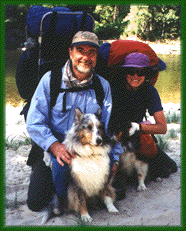

by Linda von Hanneken-Martin

Backpacking with your pooch can be a blast! Linda offers several tips to help you get started. She owns WOLF PACKS®, a high quality dog backpack manufacturer, and is an avid "dog packer."
Most dogs will love to wear the pack right from the start, others may need a little encouragement. Here are a few tips...
It is important that all dogs being considered for packing be healthy and fully mature. Even though your dog may still be growing, you can do some early training. Try placing a small towel across the dog's back while speaking in a happy voice. Even though the towel will soon fall, repeating this exercise often will create a positive association with "wearing" something on the back.
Your dog will like the new pack if you make it a part of the fun times. Put it on your dog when you go for walks together. A pair of plastic water bottles (20 to 30 ounce size) work well for training. Remember to use lots of praise. Soon just the sight of the pack will start the tail to wag happily.
Start with light loads and brief hikes. Build up gradually as long hours and heavy loads will make dog muscles sore, too. Occasionally check your dog's paws for wear. Long hikes may call for dog boots and frequent water breaks.
If your dog likes to chew things, you should discourage any pack chewing immediately. Pet stores sell a spray that tastes awful to dogs, which is very effective. (See SuperPuppy, pages 24-25.)
A dog pack should be large enough to carry the proper load. It should allow plenty of ground clearance and let the dog lie down, even when fully loaded. Panniers should permit the dog's elbows to move normally. Our designs do not have a strap behind the dog's elbows, as this is a sensitive area - especially on short haired dogs. (The label on our packs goes on the dog's right side, with the little wolf always running forward.)
Straps should be very snug, but loose enough to insert a finger beneath. In the beginning check strap fit when your dog is standing, sitting, laying down and after water breaks. Straps don't carry weight, they only keep the pack from sliding around. Packs that move a lot are probably too loose or poorly balanced. Once properly adjusted, you should rarely need to check.
Keep the panniers evenly weighted. Redistribute the load if you notice the pack riding to one side. Try to pack heavy things near the bottom and light stuff in the top area of each pannier. Make the sides equally "puffy".
Unbreakable things are best. Plastic water bottles and dog toys are ideal. A first aid kit (human and canine) is great for your dog to tote. Items that might be damaged by dampness should always be stored inside two zipable plastic bags. Other ideas include a water bowl for your dog, dog food, your food, cook pots and tools, maps & guide books, toilet paper, extra clothing...you get the idea. Almost anything goes.
PACK CARE
Hand wash your pack in warm, soapy water. Nylon fabrics do not like heat. Hang it up to air dry.
Trails are used by people, pack animals (horses, llamas, burros, goats, dogs) and wildlife. In order for everyone to get along on narrow pathways, most public land agencies require that dogs be kept on a leash.
Some areas now ban dogs from using trails. This is due to past problems which arose from off-leash activities. Check with the rangers when planning your adventure to be sure that dogs are permitted on your favorite trials.
Usually the largest animal has right-of-way on trails because they are less maneuverable. Stepping off the trial may cause them to suffer an injury. Most livestock can be spooked by dogs. If you meet a horse-packer, the courteous response is to yield by stepping off the trial with your leashed dog and allowing them to pass. Since some people are afraid of dogs, it is a good idea to yield to other hikers as well. In general, when you meet another trail user, you will be wished well if your dog is under total control.
Dog packs are ideal for removing trash from our wilderness areas. Even on a short hike you can help by packing away trail-side litter. The old saying, "Leave only footprints," applies to dog poop too. To protect wildlife and to keep other hiker's boots odor-free, please bury or dispose of any droppings.
Be sure to promote a positive image for trail dogs while you are enjoying your favorite outdoor activities. We want to keep as many trails open to dogs as possible.

|
SuperPuppy®
Press : PO Box 463030 : Escondido, CA : 92046-3030 : 1-760-489-1818 : Home Page: www.superpuppy.com |
© Peter J. Vollmer 1997-2019
© Nancy B.
Vollmer 1997-2019
© SuperPuppy® 1997-2019